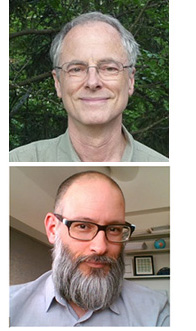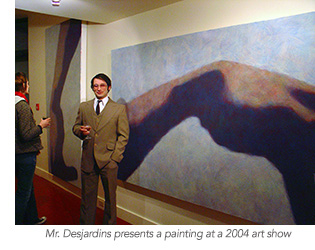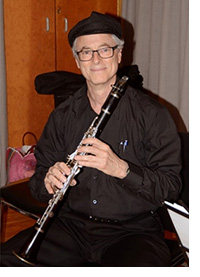The EEGLAB News #5
 Sidney J. Segalowitz, Ph.D.
Sidney J. Segalowitz, Ph.D.
Psychology Department and the Centre for Neuroscience, Brock University Founding Director, The Jack and Nora Walker Centre for Lifespan Development Research Director, Cognitive and Affective Neuroscience Lab
James Desjardins, M.A.
High Performance Computing Consultant, SHARCNET, Compute/Calcul Canada. Formerly Electrophysiology Technologist, Cognitive and Affective Neuroscience Lab, Brock University; Jack and Nora Walker Centre for Lifespan Development Research.
A team like this comes along once in a lifetime. Dr. Sid Segalowitz, Professor of Psychology and Neuroscience at Brock University, recalls a fateful meeting in 1999 when his neuropsychology student, James Desjardins, asked for advice on his Thesis. This mentorship quickly grew into a remarkable partnership.
“I took Sid’s neuropsychology course,” Mr. Desjardins describes, “and asked to do my Honours Thesis with him, and we have been working together ever since.” Dr. Segalowitz agrees: “When James joined my lab, it was a (professional) match made in heaven, and we haven’t looked back since.” From day one, this partnership changed their lives, and greatly enhanced the field of EEG and ERP research.
Beginnings. Dr. Segalowitz grew up in Montreal, studied psychology at McGill, and then received his Ph.D. at Cornell with his dissertation on language development and a minor in neurobiology. His focus quickly became based on psycholinguistic and attention phenomena, often in a developmental context.
“Graduate students also pulled me into studying individual differences, with respect to personality factors that can affect attention, depending on the stimuli and context,” Dr. Segalowitz recalls. “This eventually led to an interest in performance monitoring and the error-related negativity (ERN), both as a cognitive process and as an individual difference relating to age (both in children and older adults) and to personality (empathy, risk-taking, socialization, psychopathic traits, even political attitudes).”
When he joined Brock University in Ontario, Canada, in 1974, Dr. Segalowitz became interested in brain laterality and quickly saw that he needed a technology to reflect cortical processing more directly than the visual and auditory systems available at that time.
“So I moved into electroencephalography (EEG) and event-related potentials (ERP) studies, having to build my own system, program my own A-D conversions, and analyses. The ability to collect implicit cortical functioning this way from children was one of my goals.”
In 1988, he and his wife, Dr. Jane Dywan a professor emerita at Brock and clinical neuropsychologist, went on to found the Laboratory of Cognitive and Affective Neuroscience at Brock. But moving beyond simple scalp components was always one of his goals, and finally this became possible with the advent of fast speed, inexpensive computers and much cheaper amplifiers.
To illustrate these advances, Dr. Segalowitz recalls that his use of EEG/ERP in the late 1970s included, “…six scalp electrodes – and the hope that the field would advance enough to be able to afford more channels and derive evidence of cortical action that would be useful to cognitive psychology.”
Much has changed in the 40-some years he has been in the field. “Now we have 128-channel montages!” he laughs. “The advances in cognitive neuroscience also provided constructs that could be mapped onto EEG/ERP components that made them irresistible,” he continues. “Basically, I discovered that I was, deep down, a geek, and loved the programming and dissection of data sets.”
All along, Dr. Segalowitz had the desire to see what added value he could get from EEG data sets. And who better to help than James A. Desjardins.

“My Honours thesis,” Mr. Desjardins explains, “was on seeing whether EEG gamma (30-50 Hz) related to the size of the P3b, both conceptually related to conscious attention… A decade later, my Master’s thesis was one of the first applications of using robust statistics on ICA-derived independent components as a way to test hypotheses concerning face-discriminating ERP components P1 and N170.”
Dr. Segalowitz was so impressed with his student, that he hired Mr. Desjardins after his bachelor’s degree to run his EEG lab. This involved overseeing several high-density EEG recording systems, including ones that are portable for data acquisition with special populations, and the latest software in modelling source generators.
Mr. Desjardins recalls, “My work in the lab quickly developed into taking care of it, setting up and troubleshooting EEG machines and data analyses, and generally helping with graduate and undergraduate research projects.”
It was here where he discovered EEGLAB and ICA, and began figuring out how best to use these powerful tools. He developed analysis tools for exploring and testing complex patterns in EEG signals, including MATLAB tools compatible with EEGLAB and High-Performance Computing facilities (e.g., SHARCNet, one of Canada’s freely available high-performance computing resources) for automated artifact detection, pattern detection in continuous or segmented data, batch processing and robust bootstrap testing. He also began creating EEGLAB extensions, including the Interpmont, Batch_context, and Vised_marks extensions (see Extensions).
The partnership between Dr. Segalowitz and Mr. Desjardins proved prolific from the start. In fact, Mr. Desjardins’ Master’s thesis pulled together much of the first version of what became their preprocessing pipeline – a program used to clean up scalp data before deriving ICs for reflecting cognitive processes. And through this experience, Dr. Segalowitz became an ICA convert – something relatively unique among long-time psychologists using ERP measures.
Research. Dr. Segalowitz and Mr. Desjardins became a fine-tuned team – publishing together in the field of EEG/ERP research and each contributing his own special expertise to the partnership. They began focusing their research on methodological innovations in EEG and ERP research that allowed them to examine more deeply psychological questions of information processing and the effect of individual differences on that processing.
Dr. Segalowitz gives an example: “What happens in the human brain when people make correct or incorrect responses on simple challenge tasks, or when they make a gambling choice? The result is an interaction between the subcortical reward system of the brain and the prefrontal cortex monitoring region. We use EEG/ERPs to monitor these brain responses.”
His voice gains energy as he dives deeper into his explanation: “Human brains react to a disappointing outcome with what are called error-related ERP “components” [i.e., peaks] (especially the Medial Frontal Negativities) that are easily recorded when someone realizes they have made an error. These include the error-related negativity (ERN, or Ne) and succeeding positivity (Pe). Similarly, when one receives unexpected or unwelcome feedback concerning performance, a feedback-related negativity (FRN) is generated. We are working on understanding the cortical sources for these components and the cognitive and emotional contexts which influence their appearance, including the effects of heightened arousal during a task because of excitement.”
“Most recently,” he continues, “we have been working with techniques involving ICA (for the derivation of latent components in the ERP), ITC (inter-trial consistency measures for intra-subject variability in ERP responses), some new measures of cortical connectivity derived from EEG, and bootstrapping techniques for N=1 analyses.” (The figure above Illustrates individual differences in how, across participants, similar components capture the variance in the ERP at different times (Desjardins & Segalowitz, “Deconstructing the early visual electrocortical responses to face and house stimuli,” Journal of Vision, 2013).
Workshops. The two researchers believe strongly in the power of EEG and ERP research. So much so, that in 2014 they began hosting annual workshops in advanced methods in EEG and ERP analysis in Canada. “After a few years in the field,” Mr. Desjardins recounts, “the number of requests to help train other researchers’ graduate students on EEGLAB and to make available the new methods our team was developing became irresistible and we started an annual weeklong workshop.” Normally held in late April or early May of each year, this year’s workshop had to be cancelled due to the COVID-19 pandemic. For more information, write to Dr. Sid Segalowitz at lifespan@brocku.ca.
 Moving Forward. After working in the field of Neuropsychology for over 40 years, Dr. Segalowitz is semi-retiring this year, surrounds himself more with his much-loved grandchildren, as well as “getting more deeply into my other self, the chamber musician”. He mainly performs clarinet locally in his classical trio (with cello and piano), a new Klezmer group, and is hoping to expand into some jazz (all when the pandemic is over). (Photo: Klezmer Band Clarinetist Sid Segalowitz, credit: Congregation B'nai Israel).
Moving Forward. After working in the field of Neuropsychology for over 40 years, Dr. Segalowitz is semi-retiring this year, surrounds himself more with his much-loved grandchildren, as well as “getting more deeply into my other self, the chamber musician”. He mainly performs clarinet locally in his classical trio (with cello and piano), a new Klezmer group, and is hoping to expand into some jazz (all when the pandemic is over). (Photo: Klezmer Band Clarinetist Sid Segalowitz, credit: Congregation B'nai Israel).
Mr. Desjardins, too, took a new step, accepting a full-time position with Compute Ontario, part of the federally funded national scientific computer cluster system. He adds, “Bringing my EEG-related programming into my position with Compute Ontario and starting to collaborate with Alan Evans and his group at McGill University and the Montreal Neurological Institute, we developed a preprocessing pipeline and a set of guidelines towards building an open EEG platform for researchers.” He has built software to submit EEGLAB jobs to an available high-performance computer run by Compute Canada (the Canadian government scientific computing support agency). And he has installed his EEGLAB-based software now in the compute facilities of the ''Global Brain Project' involving teams in Cuba, China, and Canada – counterparts to the SCCN NEMAR & NSG projects in the United States.
Although both Sid and James have branched out and started new phases in their lives, they are in close contact and remain good friends. Dr. Segalowitz shares: "James was very involved in blues music and plays a mean drum, and I play clarinet, so at one of our lab parties years ago, we went all out.” He pauses, adding, “Maybe one day we’ll work together again, although perhaps in music more than the lab!”
_______________________
EEGLAB Extensions. James Desjardins has contributed several plug-in extensions to EEGLAB:
- The Interpmont extension for EEGLAB provides tools for warping EEG.chanlocs coordinates to the surface of locations in an EEGLAB recognized coordinate file. It also provides tool for interpolating sites in a loaded dataset to sites in a coordinate file as well as re-referencing a loaded dataset to the average signal of interpolated sites in a coordinate file. As such, it is used as an integral part of James’ Lossless pipeline now used by the Canadian CBrain and Global Brain Consortium projects (Canada, China, Cuba) to archive and then compute on EEG data.
- Batch_context – an EEGLAB extension for saving the EEG.history field to a text file and then formatting it so that it can be executed on multiple files sequentially on the local computer or in parallel on remote clusters.
- vised_marks – an EEGLAB extension for epoching and concatenating continuous data while collecting the rejection information to a "marks" structure (compatible for display with the "vised" extension).
R. Weistrop, June 2020